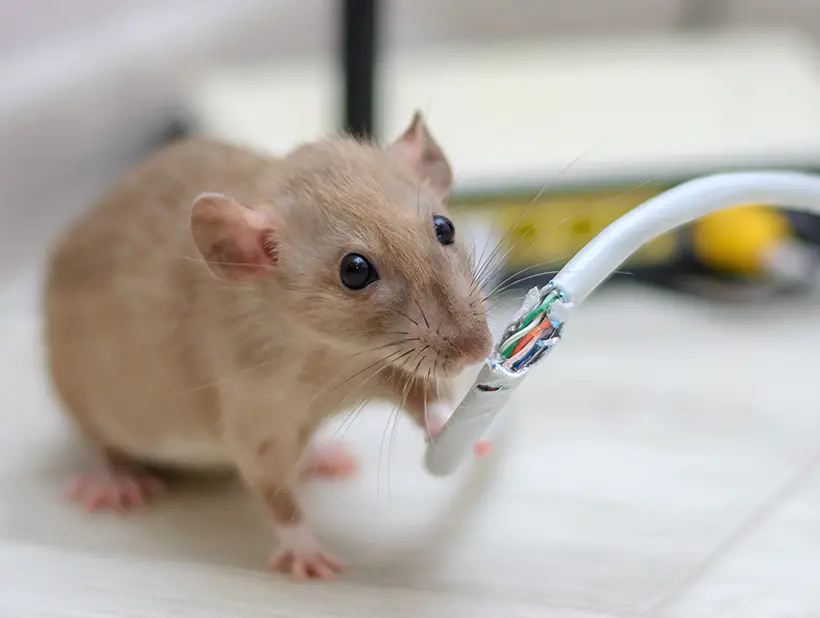How To Get Rid Of Mice In Attic Under Insulation – Expert’s Guide
Rodents seek shelter and warmth in the cozy confines of attics. And mice infestations beneath attic insulation are a common source of concern for homeowners, posing both structural and potential health risks.
But how do you get rid of mice in attic under insulation? Depending on the level of infestation, it is best to use long-term and short-term methods. Long-term solutions include removing old insulation and disinfecting the attic. The short-term solution entails using pest control methods such as trapping, trimming, etc.
Continue reading to learn about how to detect the early signs of a mouse infestation. We will also discuss the factors that attract mice to your attic and how to deal with a mouse infestation.
Signs That You Have A Mice Problem

To identify the presence of these unwanted guests, keep an eye out for the following tell-tale signs:
- Droppings: Mice leave behind small, cylindrical droppings resembling dark rice grains. Fresh droppings are dark and moist, while older ones become dry and crumbly.
- Gnawed Items: Mice have a constant need to gnaw on objects to keep their teeth from growing too long. Look for chewed wires, cardboard, plastic, and even insulation.
- Scratching Noises: Scratching or scampering sounds, especially at night, could indicate the presence of mice. They are agile climbers and can easily traverse walls and ceilings, making noises easily audible.
- Nesting Materials: Mice build nests using shredded materials like paper, fabric, and insulation. Check hidden and secluded spots in your home.
- Gaps and Holes: Mice can squeeze through tiny openings as small as a dime. Inspect your home for gaps in walls, vents, and foundation cracks, as these are common entry points for mice.
- Foul Odors: An infestation may result in a distinctive musty odor caused by mice urine and feces. This smell becomes more pronounced as the infestation grows.
- Pet Behavior: Cats and dogs may exhibit heightened interest in certain areas of the house, such as sniffing, scratching, or pawing, indicating the presence of mice.
What Attracts Mice To Your Attic?

Here are the factors that make your attic an appealing destination for these pesky rodents:
- Warmth and Shelter: Attics offer mice protection from predators and harsh weather conditions. During the colder months, attics become an appealing location for mice seeking warmth, especially if insulated, adding an extra layer of comfort.
- Type of Insulation: Fiberglass and Foam insulation in the attic are organic materials that mice may find appealing for nesting. These materials are soft and easy for mice to shred and use for building nests.
- Food Sources: Mice are opportunistic feeders who take advantage of available food sources. If you store food items in the attic, such as pet food or cardboard boxes filled with pantry items, mice will be drawn to these potential meals.
- Water Supply: Mice need water to survive, and they can find it from various sources in your attic. Leaks from the roof or condensation can provide enough moisture for mice to quench their thirst.
- Easy Access: Mice are skilled at squeezing through small openings. Attics with unsealed gaps, cracks, or holes in the walls, roof, vents, or eaves become an open invitation for these rodents to enter.
- Untouched Clutter: Clutter in the attic provides mice with ideal hiding spots and nesting materials. Boxes, old clothing, and papers are all attractive nesting materials for these rodents.
- Lack of Predator Presence: If your property lacks natural mouse predators, such as cats or birds of prey, the chances of an infestation increase. Mice prefer to live in places where they are relatively safe from predators.
How to Get Rid Of Mice In Attic Under Insulation?
Dealing with mice in your attic, especially when they are nesting under the insulation, necessitates a systematic and comprehensive approach. Consider implementing the following solutions.

Long-Term Solution
This solution is a one-time activity that entails thorough sanitation and disinfecting. From experience, pest control methods are not always effective especially because rodent waste is not dealt with. Therefore, here are the steps to follow to completely eliminate mice.
Step 1: Removing The Old Insulation
The removal of insulation is an important step in the elimination of contaminants and rodent waste. Because mouse droppings and urine can contain harmful bacteria and viruses, this process must be approached with caution.
Hiring professional insulation removal services ensures safe disposal and reduces health risks.
Why is it important to remove old insulation?
- It destroys the mice’s scent trail. Rodents have a natural instinct to mark their territory with feces and urine.
- It reveals hidden entry points that rodents use to gain access to your attic.
- It improves air quality in your home.
- It reduces the risk of contracting diseases from mice.
Step 2: Disinfection
When dealing with mouse droppings and urine, it is critical to wear appropriate protective equipment such as gloves, masks, and goggles. This avoids direct contact with potentially infectious materials and reduces health risks.
- Begin the cleaning process by vacuuming or sweeping the entire attic space.
- To trap and contain airborne particles and allergens, use a vacuum cleaner with a HEPA filter.
- Pay close attention to any corners, crevices, or hidden areas where mice may have nested.
- After cleaning, apply an appropriate disinfectant to all surfaces in the attic. Disinfectants kill or deactivate harmful bacteria, viruses, and other microorganisms. They also mask the odor of mice urine and poop.
- Proper ventilation during and after the cleaning process aids in the dissipation of lingering odors.

Step 3: Clean Your HVAC System
Mice can get into the ductwork and other components of the HVAC system, leaving droppings, urine, and nesting materials behind.
Cleaning the HVAC system thoroughly necessitates the use of specialized equipment and knowledge. Hiring professional HVAC cleaning services is best to ensure a thorough and effective cleaning process.
Step 4: Seal All Entry Points
Mice can fit through incredibly small openings, so thoroughly inspect. Gaps in walls, vents, eaves, soffits, and roof edges are common entry points.
- Once potential entry points have been identified, seal them with appropriate materials like Steel wool, caulk, expanding foam, cement, and wire mesh.
- Install weather stripping and door sweeps to create a tight seal, preventing mice from slipping through small gaps.
- Cover all vents with mesh screens to allow airflow while keeping rodents out. Use screens with a small mesh size to keep even the tiniest mice out.
- Inspect the exterior of your home, including the foundation and roof, for potential entry points. Seal any cracks or openings found, ensuring mice have no access points to the attic.
- Ensure outdoor trash bins have tight-fitting lids and are secured to prevent mice from accessing food sources near your home.
Note that sealing entry points keeps out mice and improves energy efficiency, reduces utility bills, and enhances indoor comfort.
Step 5: Installing New Insulation
Here’s a comprehensive explanation of the process of installing new insulation:
- Choose the Right Insulation Material
When replacing insulation, choose materials that are less appealing to mice for nesting. Rodent-resistant insulation options include spray foam insulation and rock wool.
- Determine the R-Value
The R-value of insulation indicates its thermal resistance or how effective it is at resisting heat transfer. Consider the climate in your area as well as the recommended R-value for attics to ensure maximum energy efficiency.
- Insulate the Attic Floor
Lay the new insulation evenly over the attic floor, covering all gaps and ensuring a continuous layer of insulation.
- Use Vapor Barriers
Consider using vapor barriers to keep moisture out of your insulation. However, this depends on your climate and local building codes.
- Insulate Attic Access Points
Insulate attic access points such as the hatch or access door to maintain a consistent thermal envelope. For a tight seal, use the same insulation material used on the attic floor and weather-strip the access points.
- Insulate Ductwork
If the HVAC ducts run through the attic, consider insulating them as well. Insulated ductwork prevents energy loss and reduces temperature variations in the attic, making it less appealing to mice looking for warmth.
Short-Term Solution
Short-term solutions act as preventative and maintenance measures in keeping mice away. The following solutions can be done as maintenance measures after employing the above 5-step solution.

Step 1: Pest Control
Implementing pest control measures is a quick way to address the existing mouse infestation.
- Set up snap traps, live traps, glue board traps, shock traps, or electronic traps throughout the attic.
- Place traps in hidden and safe locations away from children and pets.
- Regularly inspect the traps and dispose of any captured mice. Also, pest control companies may administer rodent repellents.
- Call pest control 2-3 times annually to ensure you deal with any mice that might have found their way into your home.
Step 2: Get a Cat
If you are comfortable with pets, getting a cat can be an effective short-term solution. Cats are natural hunters and can help keep mice at bay.
Step 3: Trim Bushes Around Your House
Keep vegetation near your house well-trimmed and away from the walls. Overgrown bushes and shrubs can provide hiding spots and easy access points for mice to enter your home.
Step 4: Use Natural Methods
Certain natural repellents can act as short-term deterrents for mice.
- Peppermint oil, for example, has a strong scent that mice dislike. Soak cotton balls in peppermint oil and place them strategically around the attic.
- Other methods include clove oil, ammonia, and cat litter.
Step 5: Proper Sanitation
- Maintaining proper sanitation in the attic and surrounding areas can deter mice from staying or returning.
- Check the attic for any food sources, such as uncovered trash or food debris.
- Keep the area clean and clutter-free.
Here is a video to help you out.
FAQs
Here are other related questions homeowners ask about this topic.
Q1. How much does it cost to get rid of mice from your attic?
The cost of removing mice from your attic varies depending on the severity of the infestation, your location, and the method of extermination used. Professional services can range from $300 to $1,500, while do-it-yourself solutions can be less expensive.
Q2. How long does it take to perform the long-term solution to get rid of mice from the attic?
On average, the process takes one or two days to complete. However, the duration is dependent on the size of your attic.
Q3. Should I use poison as a means of eliminating rats from the attic?
Using poison can be risky, especially when poisoned mice die in hidden areas, causing unpleasant odors and attracting other pests. If you have to use poison, use mouse blocks, which dehydrate and dry the mouse’s body. This way, if the mouse dies, it does not rot and smell.
Conclusion
Dealing with mice in your attic under insulation necessitates a methodical approach. This is a method that combines long-term strategies for permanent eradication with short-term solutions for immediate control.
Remember that professional assistance may be required for insulation removal and complete rodent-proofing. By combining these efforts, you can reclaim your attic space, protect your home, and enjoy the peace of mind that comes with a mouse-free living space.




